Management Report: GrainCorp's Competitive Reality in Australia
VerifiedAdded on 2022/10/16
|10
|2177
|176
Report
AI Summary
This report provides a comprehensive analysis of GrainCorp's competitive reality in the Australian market. It examines the company's main competitors, including Ridley, Alltech, and Nutreco, and analyzes their strategies, strengths, and weaknesses. The report delves into competitive behavior drivers, such as innovation and cost leadership, and assesses the extent of competitive rivalry within the industry. It evaluates GrainCorp's financial position and market share, highlighting its strengths and challenges. The report also provides recommendations for GrainCorp to maintain its position in the market through joint ventures and resource management. The report concludes by assessing the overall impact of the grain industry on the Australian economy and suggests strategies for future expansion.
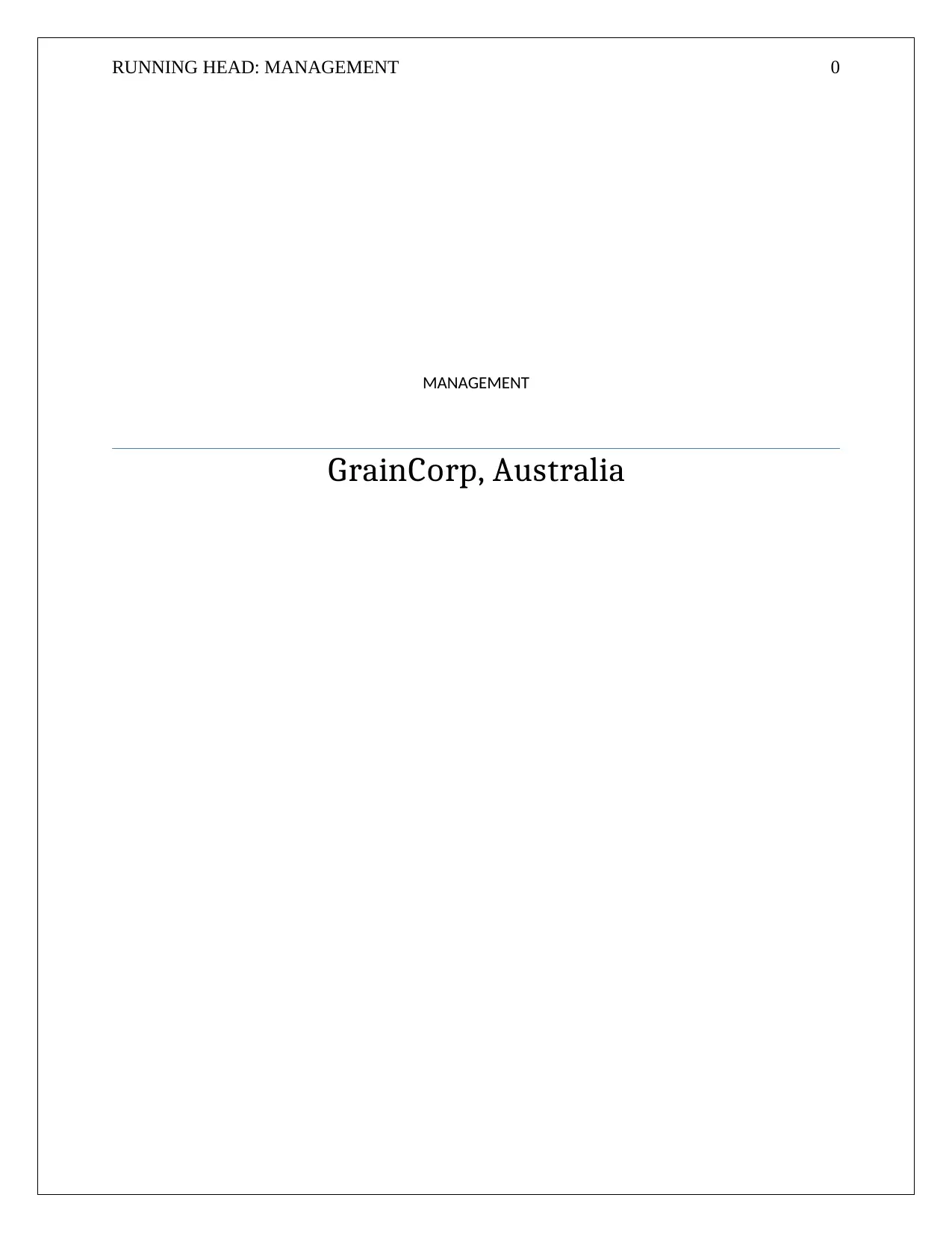
RUNNING HEAD: MANAGEMENT 0
MANAGEMENT
GrainCorp, Australia
MANAGEMENT
GrainCorp, Australia
Paraphrase This Document
Need a fresh take? Get an instant paraphrase of this document with our AI Paraphraser

MANAGEMENT 1
Model of competitive reality
The competitive reality supports the company to recognize as well as understand the behavior of
the competitors to de crease the uncertainty and threats which are related through it. However,
through this the organization can predict their position in the market as well as financial
performance to understand whether they done the right investigation of the behavior of their
competitors. If the financial as well as Market position of the company are degrading than the
suitable opinions will be given to the company (Armstrong & Taylor, 2017).
Source: (Ridgway et al., 2015)
Competitor analysis
It is the strategy adopted by the companies for assessing their competitors and to identifying the
strengths as well as weaknesses to know the opportunities and threats for the company. The main
competitors of GrainCrop in Australia are Ridley, Alltech, Nutreco. Ridley provides the high
quality products to the consumers which earns the revenue about $1.00billion. (Ridgway et al.,
2015). Alltech is also considered the major competitor of GrainCrop with the revenue up to $2
billion in the year 2016. Alltech use various strategies to attract the large number of customers
that is conducting the research and development programs at the universities, research
organizations as well as conducting the projects to advice on the farm, this helps the company in
increasing the value among the customers (Armstrong & Taylor, 2017). In the year 2017 the
Competitor
analysis
Competitive behavior
drivers
Competitive Rivalry Analysis of
outcomes
Model of competitive reality
The competitive reality supports the company to recognize as well as understand the behavior of
the competitors to de crease the uncertainty and threats which are related through it. However,
through this the organization can predict their position in the market as well as financial
performance to understand whether they done the right investigation of the behavior of their
competitors. If the financial as well as Market position of the company are degrading than the
suitable opinions will be given to the company (Armstrong & Taylor, 2017).
Source: (Ridgway et al., 2015)
Competitor analysis
It is the strategy adopted by the companies for assessing their competitors and to identifying the
strengths as well as weaknesses to know the opportunities and threats for the company. The main
competitors of GrainCrop in Australia are Ridley, Alltech, Nutreco. Ridley provides the high
quality products to the consumers which earns the revenue about $1.00billion. (Ridgway et al.,
2015). Alltech is also considered the major competitor of GrainCrop with the revenue up to $2
billion in the year 2016. Alltech use various strategies to attract the large number of customers
that is conducting the research and development programs at the universities, research
organizations as well as conducting the projects to advice on the farm, this helps the company in
increasing the value among the customers (Armstrong & Taylor, 2017). In the year 2017 the
Competitor
analysis
Competitive behavior
drivers
Competitive Rivalry Analysis of
outcomes
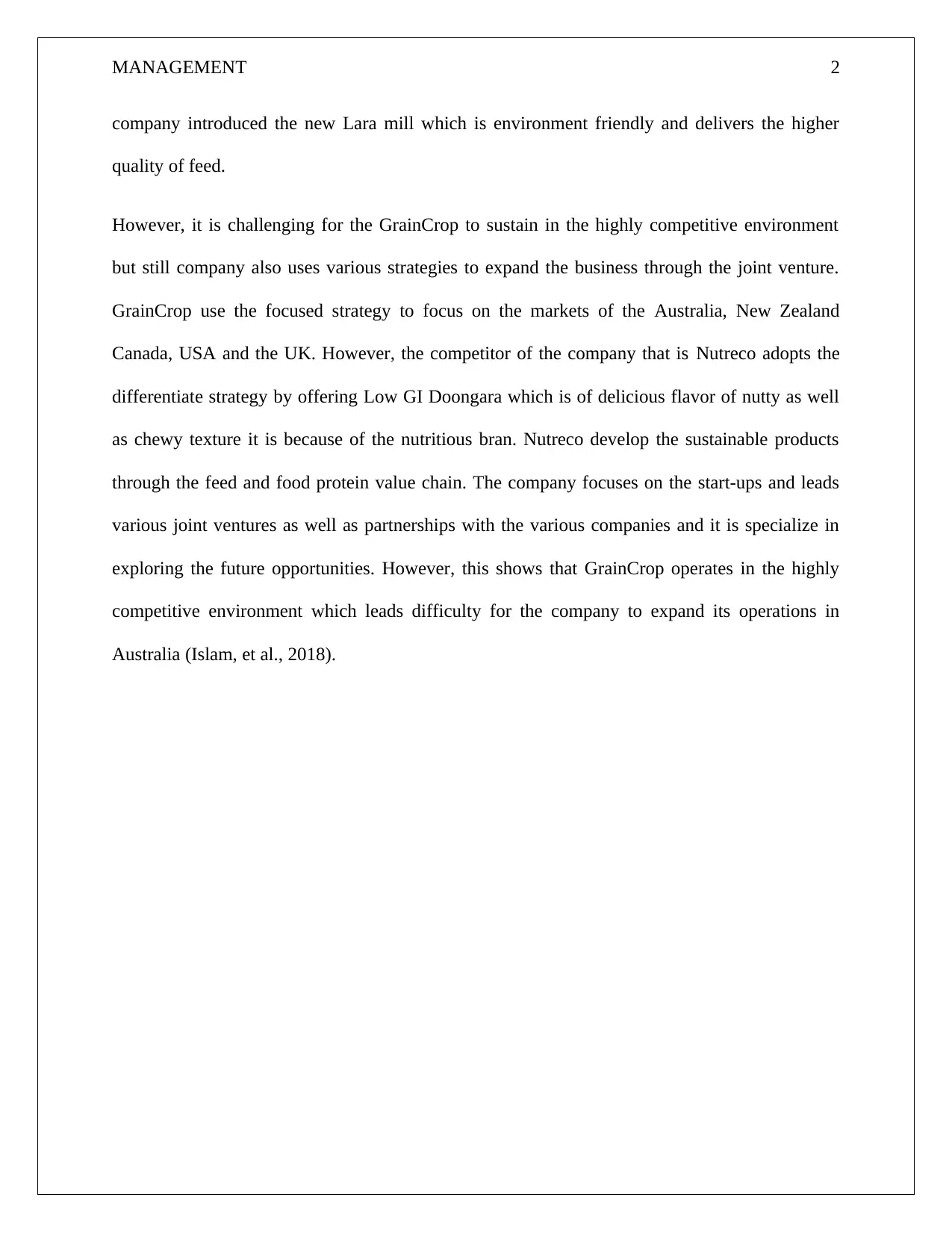
MANAGEMENT 2
company introduced the new Lara mill which is environment friendly and delivers the higher
quality of feed.
However, it is challenging for the GrainCrop to sustain in the highly competitive environment
but still company also uses various strategies to expand the business through the joint venture.
GrainCrop use the focused strategy to focus on the markets of the Australia, New Zealand
Canada, USA and the UK. However, the competitor of the company that is Nutreco adopts the
differentiate strategy by offering Low GI Doongara which is of delicious flavor of nutty as well
as chewy texture it is because of the nutritious bran. Nutreco develop the sustainable products
through the feed and food protein value chain. The company focuses on the start-ups and leads
various joint ventures as well as partnerships with the various companies and it is specialize in
exploring the future opportunities. However, this shows that GrainCrop operates in the highly
competitive environment which leads difficulty for the company to expand its operations in
Australia (Islam, et al., 2018).
company introduced the new Lara mill which is environment friendly and delivers the higher
quality of feed.
However, it is challenging for the GrainCrop to sustain in the highly competitive environment
but still company also uses various strategies to expand the business through the joint venture.
GrainCrop use the focused strategy to focus on the markets of the Australia, New Zealand
Canada, USA and the UK. However, the competitor of the company that is Nutreco adopts the
differentiate strategy by offering Low GI Doongara which is of delicious flavor of nutty as well
as chewy texture it is because of the nutritious bran. Nutreco develop the sustainable products
through the feed and food protein value chain. The company focuses on the start-ups and leads
various joint ventures as well as partnerships with the various companies and it is specialize in
exploring the future opportunities. However, this shows that GrainCrop operates in the highly
competitive environment which leads difficulty for the company to expand its operations in
Australia (Islam, et al., 2018).
⊘ This is a preview!⊘
Do you want full access?
Subscribe today to unlock all pages.

Trusted by 1+ million students worldwide
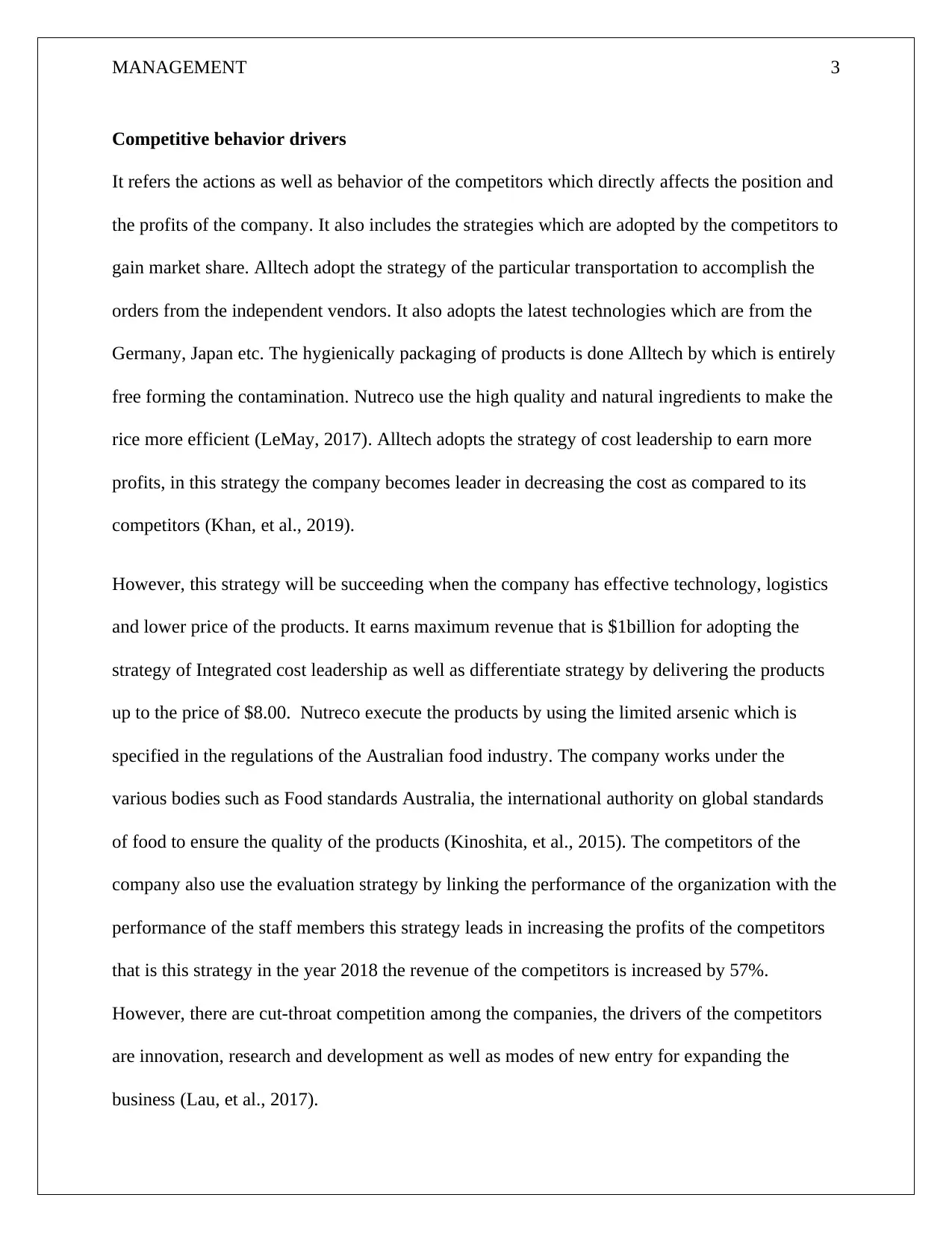
MANAGEMENT 3
Competitive behavior drivers
It refers the actions as well as behavior of the competitors which directly affects the position and
the profits of the company. It also includes the strategies which are adopted by the competitors to
gain market share. Alltech adopt the strategy of the particular transportation to accomplish the
orders from the independent vendors. It also adopts the latest technologies which are from the
Germany, Japan etc. The hygienically packaging of products is done Alltech by which is entirely
free forming the contamination. Nutreco use the high quality and natural ingredients to make the
rice more efficient (LeMay, 2017). Alltech adopts the strategy of cost leadership to earn more
profits, in this strategy the company becomes leader in decreasing the cost as compared to its
competitors (Khan, et al., 2019).
However, this strategy will be succeeding when the company has effective technology, logistics
and lower price of the products. It earns maximum revenue that is $1billion for adopting the
strategy of Integrated cost leadership as well as differentiate strategy by delivering the products
up to the price of $8.00. Nutreco execute the products by using the limited arsenic which is
specified in the regulations of the Australian food industry. The company works under the
various bodies such as Food standards Australia, the international authority on global standards
of food to ensure the quality of the products (Kinoshita, et al., 2015). The competitors of the
company also use the evaluation strategy by linking the performance of the organization with the
performance of the staff members this strategy leads in increasing the profits of the competitors
that is this strategy in the year 2018 the revenue of the competitors is increased by 57%.
However, there are cut-throat competition among the companies, the drivers of the competitors
are innovation, research and development as well as modes of new entry for expanding the
business (Lau, et al., 2017).
Competitive behavior drivers
It refers the actions as well as behavior of the competitors which directly affects the position and
the profits of the company. It also includes the strategies which are adopted by the competitors to
gain market share. Alltech adopt the strategy of the particular transportation to accomplish the
orders from the independent vendors. It also adopts the latest technologies which are from the
Germany, Japan etc. The hygienically packaging of products is done Alltech by which is entirely
free forming the contamination. Nutreco use the high quality and natural ingredients to make the
rice more efficient (LeMay, 2017). Alltech adopts the strategy of cost leadership to earn more
profits, in this strategy the company becomes leader in decreasing the cost as compared to its
competitors (Khan, et al., 2019).
However, this strategy will be succeeding when the company has effective technology, logistics
and lower price of the products. It earns maximum revenue that is $1billion for adopting the
strategy of Integrated cost leadership as well as differentiate strategy by delivering the products
up to the price of $8.00. Nutreco execute the products by using the limited arsenic which is
specified in the regulations of the Australian food industry. The company works under the
various bodies such as Food standards Australia, the international authority on global standards
of food to ensure the quality of the products (Kinoshita, et al., 2015). The competitors of the
company also use the evaluation strategy by linking the performance of the organization with the
performance of the staff members this strategy leads in increasing the profits of the competitors
that is this strategy in the year 2018 the revenue of the competitors is increased by 57%.
However, there are cut-throat competition among the companies, the drivers of the competitors
are innovation, research and development as well as modes of new entry for expanding the
business (Lau, et al., 2017).
Paraphrase This Document
Need a fresh take? Get an instant paraphrase of this document with our AI Paraphraser

MANAGEMENT 4
Competitive Rivalry
It is considered the extent of competition held between the firms in the same industry and offer
similar products. However, high competition will lead the company to raise the expenditure of
advertisement, enhancement in the product. As discussed, the competitors of Grain Corp adopt
various strategies to increase the value as well as provide high quality product to increase the
value among the customers (Lindberg, et al., 2017). Competitive rivalry is a proportion of the
degree of rivalry among existing firms. Serious contention can restrain benefits and lead to
aggressive moves including cost cutting, expanded promoting uses, or spending on
administration/item enhancements and advancement. The competitors of the company are:
Ridley, Alltech, Purina, Kemin, Novus and DSM (Armstrong & Taylor, 2017).
GrainCorp works eastern Australia's greatest grain port, taking care of as much as 60 percent of
the district's wheat, grain, canola, chickpea and sorghum crops, and has in excess of 280 inland
grain taking care of locales. Western Australian grain exporter CBH Group and product
merchant Glencore Xstrata are among patrons of another grain industry’s terminal in Newcastle
on Australia's east coast because of open one month from now close to GrainCorp's own
terminal. GrainCorp's stockpiling and taking care of business is confronting opponents, for
example, Singapore-based Olam International and Emerald Grain, half-possessed by Japan's
Sumitomo Corp, as predominantly state-based gatherings and new remote players move into a
one another's area after a time of industry solidification (Kinoshita, et al., 2015).
The competitors of the company are planning to build new capacity resources over the eastern
seaboard. GrainCorp is getting update from their ranchers for utilizing its up-nation stockpiling
destinations and possibly redirecting clients of its rail and port system. Apart from this, the new
Newcastle Agri Terminal is found only a short stroll from the current Carrington Port claimed by
Competitive Rivalry
It is considered the extent of competition held between the firms in the same industry and offer
similar products. However, high competition will lead the company to raise the expenditure of
advertisement, enhancement in the product. As discussed, the competitors of Grain Corp adopt
various strategies to increase the value as well as provide high quality product to increase the
value among the customers (Lindberg, et al., 2017). Competitive rivalry is a proportion of the
degree of rivalry among existing firms. Serious contention can restrain benefits and lead to
aggressive moves including cost cutting, expanded promoting uses, or spending on
administration/item enhancements and advancement. The competitors of the company are:
Ridley, Alltech, Purina, Kemin, Novus and DSM (Armstrong & Taylor, 2017).
GrainCorp works eastern Australia's greatest grain port, taking care of as much as 60 percent of
the district's wheat, grain, canola, chickpea and sorghum crops, and has in excess of 280 inland
grain taking care of locales. Western Australian grain exporter CBH Group and product
merchant Glencore Xstrata are among patrons of another grain industry’s terminal in Newcastle
on Australia's east coast because of open one month from now close to GrainCorp's own
terminal. GrainCorp's stockpiling and taking care of business is confronting opponents, for
example, Singapore-based Olam International and Emerald Grain, half-possessed by Japan's
Sumitomo Corp, as predominantly state-based gatherings and new remote players move into a
one another's area after a time of industry solidification (Kinoshita, et al., 2015).
The competitors of the company are planning to build new capacity resources over the eastern
seaboard. GrainCorp is getting update from their ranchers for utilizing its up-nation stockpiling
destinations and possibly redirecting clients of its rail and port system. Apart from this, the new
Newcastle Agri Terminal is found only a short stroll from the current Carrington Port claimed by
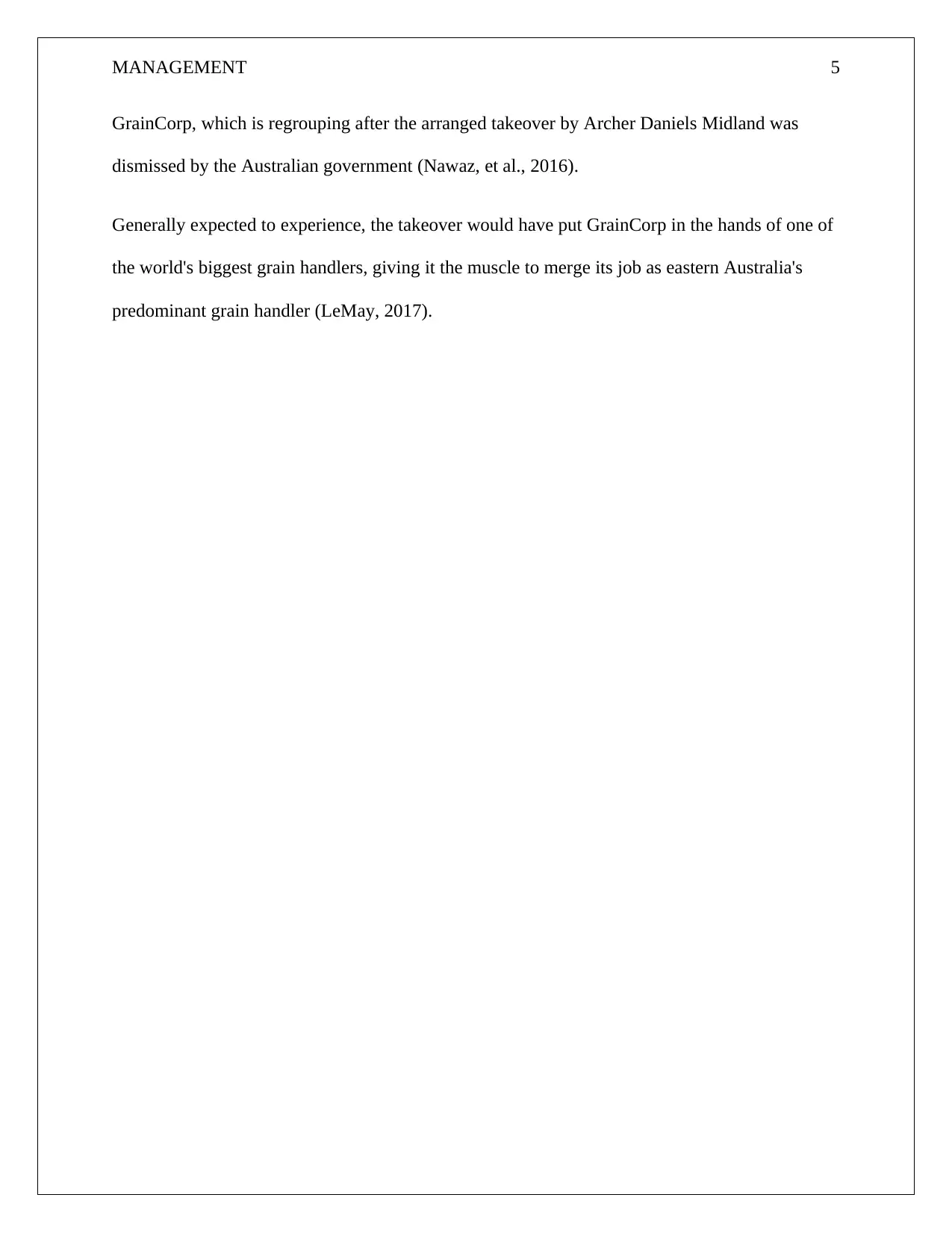
MANAGEMENT 5
GrainCorp, which is regrouping after the arranged takeover by Archer Daniels Midland was
dismissed by the Australian government (Nawaz, et al., 2016).
Generally expected to experience, the takeover would have put GrainCorp in the hands of one of
the world's biggest grain handlers, giving it the muscle to merge its job as eastern Australia's
predominant grain handler (LeMay, 2017).
GrainCorp, which is regrouping after the arranged takeover by Archer Daniels Midland was
dismissed by the Australian government (Nawaz, et al., 2016).
Generally expected to experience, the takeover would have put GrainCorp in the hands of one of
the world's biggest grain handlers, giving it the muscle to merge its job as eastern Australia's
predominant grain handler (LeMay, 2017).
⊘ This is a preview!⊘
Do you want full access?
Subscribe today to unlock all pages.

Trusted by 1+ million students worldwide

MANAGEMENT 6
Analysis of outcomes
The financial position of Green Corp is better than that of the competitors, that is in the year
2017 the revenue of the company was A$1.1 billion as well as the profit generated by the
company was up to A$34.2 million (Uraipong & Zhao, 2016). However, the company is
operating under the moderate competition, Green Corp internal capabilities leads the company to
being in profitability that are providing the superior quality products, deal with obesity as well as
diabetes, assuring the sustainability and quality through the traceability (GrainCorp, 2019).
However, if we link this part to the overall grains industry in Australia then it is noted that the
grains industry makes a significant commitment to the Australian economy. In 2017–18, creation
of grains, oilseeds and heartbeat harvests represented around 21 percent ($12.8 billion) of the
absolute gross estimation of ranch generation and around 23 percent of the all-out estimation of
homestead send out salary (GrainCorp, 2019).
Around 26 percent of every single Australian homestead delivered grains, oilseeds and
heartbeats in 2017–18 (ABS 2019a). Wheat is the most significant individual yield by tonnage
and worth. In 2017–18, the GVP for wheat was $5.8 billion, around 45 percent of all out GVP
for the grains business (ABS 2019b). Absolute generation of wheat in 2017–18 was around 20.9
million tons or 49 percent of all out grains industry tonnage (GrainCorp, 2019).
It is recommended that the Grain Corp is the well-established company of Australia and earns
sufficient revenues to sustain in the competitive environment. However, still the company faces
various challenges which include lower expansion due to raise in the international competition,
scarcity of the land as well as water etc (Ridgway, et al., 2015). To overcome these challenges,
the company can adopt the strategy of joint venture (Syller & Grupa, 2016). The company can do
Analysis of outcomes
The financial position of Green Corp is better than that of the competitors, that is in the year
2017 the revenue of the company was A$1.1 billion as well as the profit generated by the
company was up to A$34.2 million (Uraipong & Zhao, 2016). However, the company is
operating under the moderate competition, Green Corp internal capabilities leads the company to
being in profitability that are providing the superior quality products, deal with obesity as well as
diabetes, assuring the sustainability and quality through the traceability (GrainCorp, 2019).
However, if we link this part to the overall grains industry in Australia then it is noted that the
grains industry makes a significant commitment to the Australian economy. In 2017–18, creation
of grains, oilseeds and heartbeat harvests represented around 21 percent ($12.8 billion) of the
absolute gross estimation of ranch generation and around 23 percent of the all-out estimation of
homestead send out salary (GrainCorp, 2019).
Around 26 percent of every single Australian homestead delivered grains, oilseeds and
heartbeats in 2017–18 (ABS 2019a). Wheat is the most significant individual yield by tonnage
and worth. In 2017–18, the GVP for wheat was $5.8 billion, around 45 percent of all out GVP
for the grains business (ABS 2019b). Absolute generation of wheat in 2017–18 was around 20.9
million tons or 49 percent of all out grains industry tonnage (GrainCorp, 2019).
It is recommended that the Grain Corp is the well-established company of Australia and earns
sufficient revenues to sustain in the competitive environment. However, still the company faces
various challenges which include lower expansion due to raise in the international competition,
scarcity of the land as well as water etc (Ridgway, et al., 2015). To overcome these challenges,
the company can adopt the strategy of joint venture (Syller & Grupa, 2016). The company can do
Paraphrase This Document
Need a fresh take? Get an instant paraphrase of this document with our AI Paraphraser
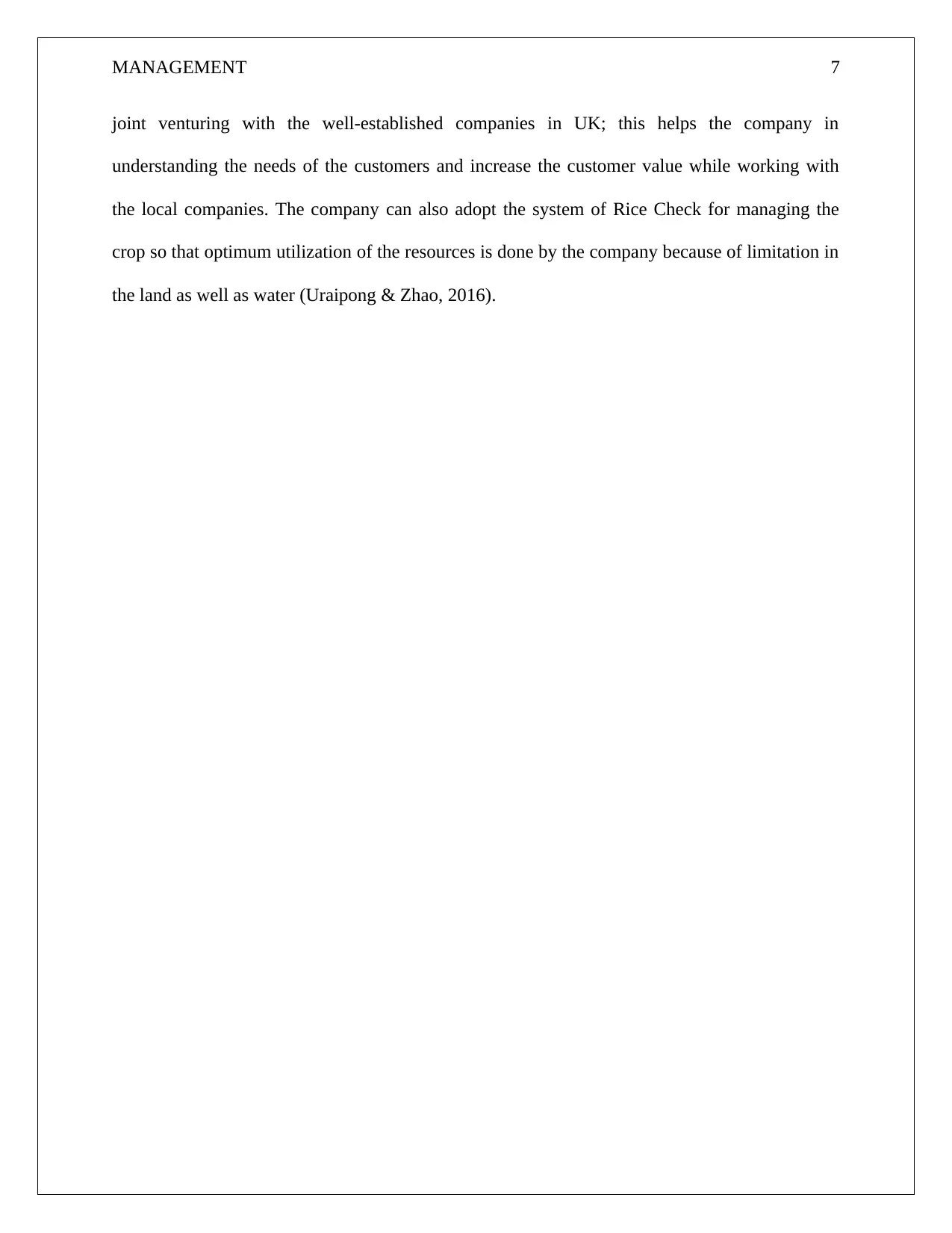
MANAGEMENT 7
joint venturing with the well-established companies in UK; this helps the company in
understanding the needs of the customers and increase the customer value while working with
the local companies. The company can also adopt the system of Rice Check for managing the
crop so that optimum utilization of the resources is done by the company because of limitation in
the land as well as water (Uraipong & Zhao, 2016).
joint venturing with the well-established companies in UK; this helps the company in
understanding the needs of the customers and increase the customer value while working with
the local companies. The company can also adopt the system of Rice Check for managing the
crop so that optimum utilization of the resources is done by the company because of limitation in
the land as well as water (Uraipong & Zhao, 2016).
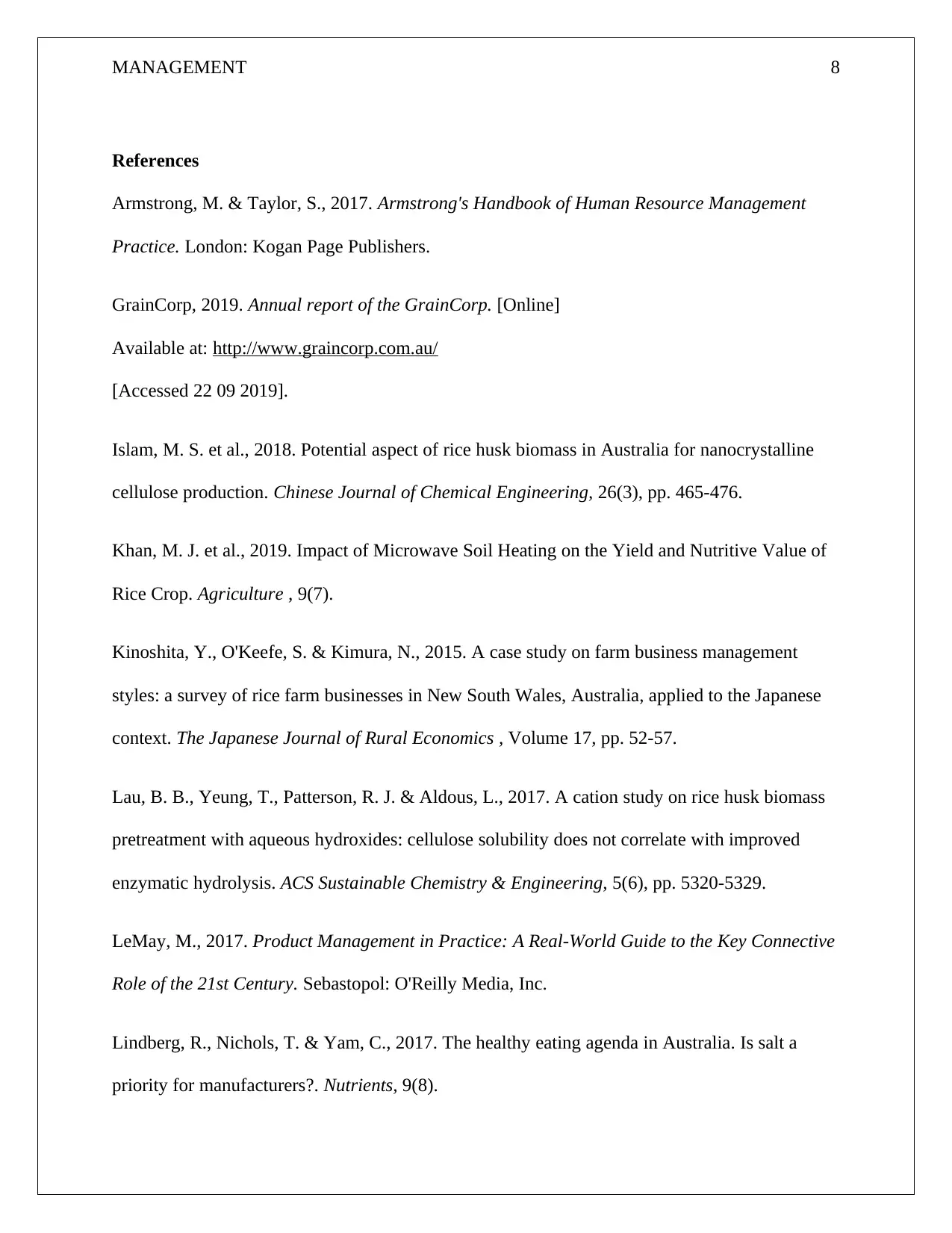
MANAGEMENT 8
References
Armstrong, M. & Taylor, S., 2017. Armstrong's Handbook of Human Resource Management
Practice. London: Kogan Page Publishers.
GrainCorp, 2019. Annual report of the GrainCorp. [Online]
Available at: http://www.graincorp.com.au/
[Accessed 22 09 2019].
Islam, M. S. et al., 2018. Potential aspect of rice husk biomass in Australia for nanocrystalline
cellulose production. Chinese Journal of Chemical Engineering, 26(3), pp. 465-476.
Khan, M. J. et al., 2019. Impact of Microwave Soil Heating on the Yield and Nutritive Value of
Rice Crop. Agriculture , 9(7).
Kinoshita, Y., O'Keefe, S. & Kimura, N., 2015. A case study on farm business management
styles: a survey of rice farm businesses in New South Wales, Australia, applied to the Japanese
context. The Japanese Journal of Rural Economics , Volume 17, pp. 52-57.
Lau, B. B., Yeung, T., Patterson, R. J. & Aldous, L., 2017. A cation study on rice husk biomass
pretreatment with aqueous hydroxides: cellulose solubility does not correlate with improved
enzymatic hydrolysis. ACS Sustainable Chemistry & Engineering, 5(6), pp. 5320-5329.
LeMay, M., 2017. Product Management in Practice: A Real-World Guide to the Key Connective
Role of the 21st Century. Sebastopol: O'Reilly Media, Inc.
Lindberg, R., Nichols, T. & Yam, C., 2017. The healthy eating agenda in Australia. Is salt a
priority for manufacturers?. Nutrients, 9(8).
References
Armstrong, M. & Taylor, S., 2017. Armstrong's Handbook of Human Resource Management
Practice. London: Kogan Page Publishers.
GrainCorp, 2019. Annual report of the GrainCorp. [Online]
Available at: http://www.graincorp.com.au/
[Accessed 22 09 2019].
Islam, M. S. et al., 2018. Potential aspect of rice husk biomass in Australia for nanocrystalline
cellulose production. Chinese Journal of Chemical Engineering, 26(3), pp. 465-476.
Khan, M. J. et al., 2019. Impact of Microwave Soil Heating on the Yield and Nutritive Value of
Rice Crop. Agriculture , 9(7).
Kinoshita, Y., O'Keefe, S. & Kimura, N., 2015. A case study on farm business management
styles: a survey of rice farm businesses in New South Wales, Australia, applied to the Japanese
context. The Japanese Journal of Rural Economics , Volume 17, pp. 52-57.
Lau, B. B., Yeung, T., Patterson, R. J. & Aldous, L., 2017. A cation study on rice husk biomass
pretreatment with aqueous hydroxides: cellulose solubility does not correlate with improved
enzymatic hydrolysis. ACS Sustainable Chemistry & Engineering, 5(6), pp. 5320-5329.
LeMay, M., 2017. Product Management in Practice: A Real-World Guide to the Key Connective
Role of the 21st Century. Sebastopol: O'Reilly Media, Inc.
Lindberg, R., Nichols, T. & Yam, C., 2017. The healthy eating agenda in Australia. Is salt a
priority for manufacturers?. Nutrients, 9(8).
⊘ This is a preview!⊘
Do you want full access?
Subscribe today to unlock all pages.

Trusted by 1+ million students worldwide
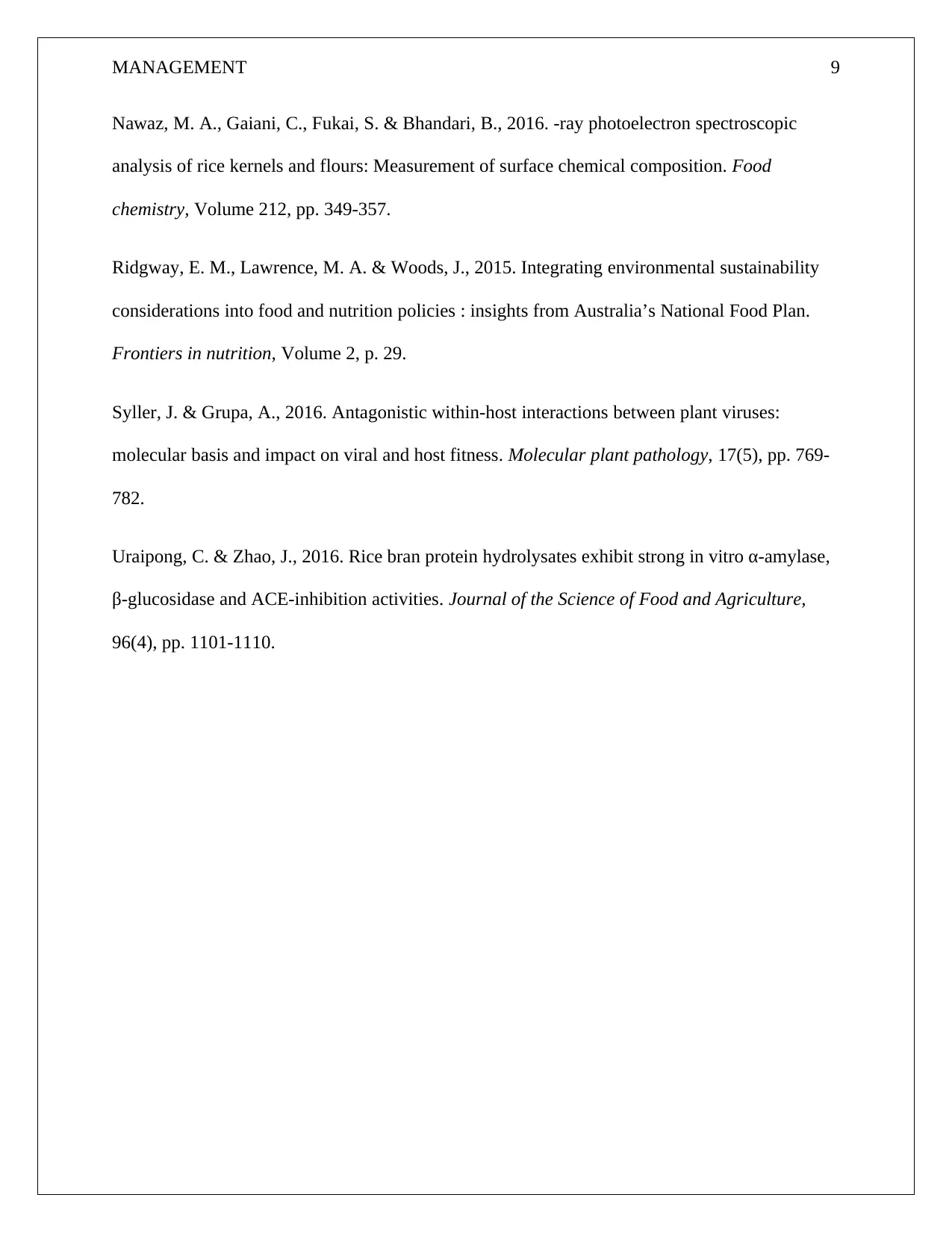
MANAGEMENT 9
Nawaz, M. A., Gaiani, C., Fukai, S. & Bhandari, B., 2016. -ray photoelectron spectroscopic
analysis of rice kernels and flours: Measurement of surface chemical composition. Food
chemistry, Volume 212, pp. 349-357.
Ridgway, E. M., Lawrence, M. A. & Woods, J., 2015. Integrating environmental sustainability
considerations into food and nutrition policies : insights from Australia’s National Food Plan.
Frontiers in nutrition, Volume 2, p. 29.
Syller, J. & Grupa, A., 2016. Antagonistic within‐host interactions between plant viruses:
molecular basis and impact on viral and host fitness. Molecular plant pathology, 17(5), pp. 769-
782.
Uraipong, C. & Zhao, J., 2016. Rice bran protein hydrolysates exhibit strong in vitro α‐amylase,
β‐glucosidase and ACE‐inhibition activities. Journal of the Science of Food and Agriculture,
96(4), pp. 1101-1110.
Nawaz, M. A., Gaiani, C., Fukai, S. & Bhandari, B., 2016. -ray photoelectron spectroscopic
analysis of rice kernels and flours: Measurement of surface chemical composition. Food
chemistry, Volume 212, pp. 349-357.
Ridgway, E. M., Lawrence, M. A. & Woods, J., 2015. Integrating environmental sustainability
considerations into food and nutrition policies : insights from Australia’s National Food Plan.
Frontiers in nutrition, Volume 2, p. 29.
Syller, J. & Grupa, A., 2016. Antagonistic within‐host interactions between plant viruses:
molecular basis and impact on viral and host fitness. Molecular plant pathology, 17(5), pp. 769-
782.
Uraipong, C. & Zhao, J., 2016. Rice bran protein hydrolysates exhibit strong in vitro α‐amylase,
β‐glucosidase and ACE‐inhibition activities. Journal of the Science of Food and Agriculture,
96(4), pp. 1101-1110.
1 out of 10
Related Documents
Your All-in-One AI-Powered Toolkit for Academic Success.
+13062052269
info@desklib.com
Available 24*7 on WhatsApp / Email
![[object Object]](/_next/static/media/star-bottom.7253800d.svg)
Unlock your academic potential
Copyright © 2020–2025 A2Z Services. All Rights Reserved. Developed and managed by ZUCOL.





